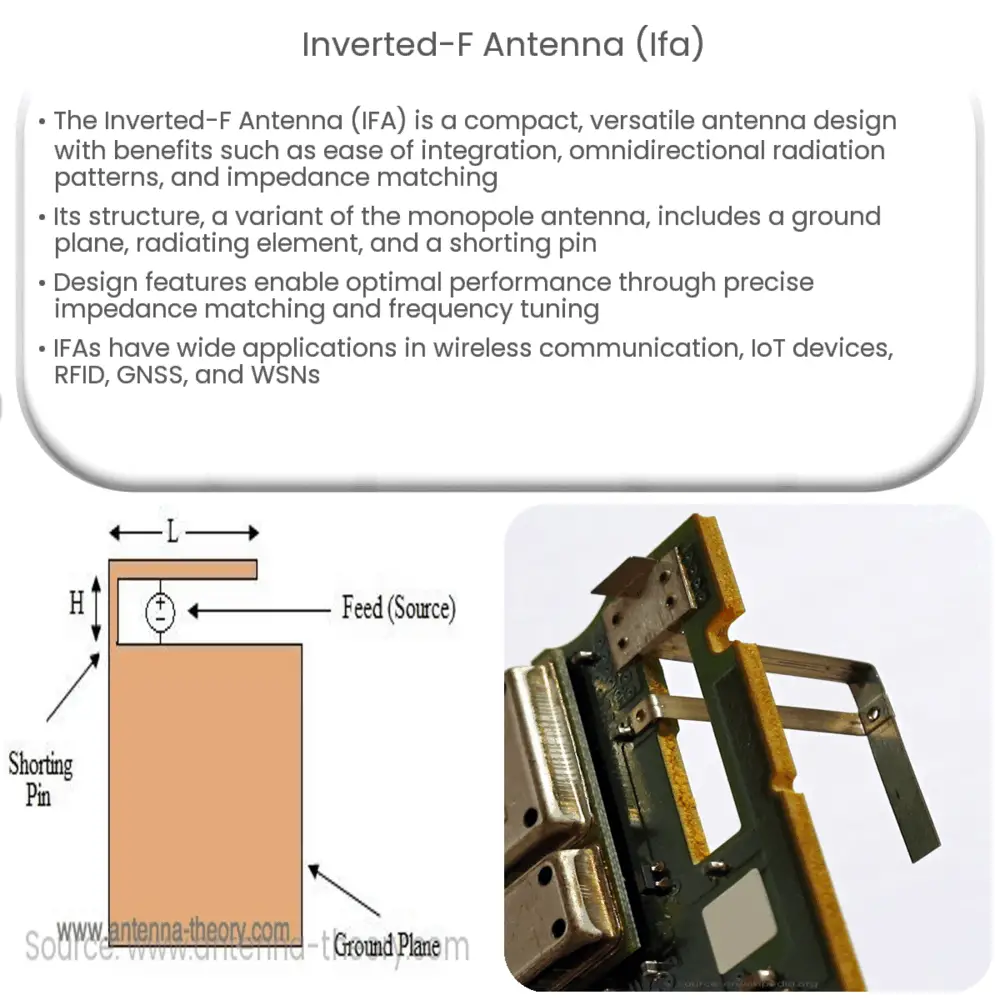The Inverted-F Antenna (IFA) is a compact, versatile design offering omnidirectional radiation, impedance matching, and wideband performance, ideal for wireless communication and IoT devices.

Inverted-F Antenna (IFA): Design, Advantages, and Applications
Introduction to Inverted-F Antenna (IFA)
Inverted-F Antenna (IFA) is a widely used and versatile antenna design that has found applications in various fields such as wireless communication, radio frequency identification (RFID), and Internet of Things (IoT) devices. The IFA is a compact, planar antenna that offers several advantages, including ease of integration, omnidirectional radiation patterns, and impedance matching capabilities.
Design and Structure of an IFA
The Inverted-F Antenna is a derivative of the monopole antenna, which is essentially a quarter-wavelength resonant structure. The design of an IFA consists of a ground plane, a radiating element, and a shorting pin that connects the radiating element to the ground plane. The radiating element, which is typically a thin conductive strip or wire, is bent into an inverted-F shape, giving the antenna its name.
The length of the radiating element is critical in determining the resonant frequency of the IFA. By adjusting the length of the radiating element, the antenna can be tuned to operate at a specific frequency. In addition, the position of the shorting pin and the feed point can be adjusted to achieve optimal impedance matching, which helps to improve the antenna’s efficiency and performance.
Advantages of Inverted-F Antennas
There are several advantages to using an Inverted-F Antenna in various applications:
- Compact Size: The IFA’s design allows it to be smaller than a conventional quarter-wavelength monopole antenna, making it suitable for integration into space-constrained devices and systems.
- Impedance Matching: The IFA’s design allows for the adjustment of the shorting pin and feed point to achieve an optimal impedance match with the feeding transmission line, improving the antenna’s efficiency and reducing signal loss.
- Omnidirectional Radiation Pattern: The IFA typically exhibits an omnidirectional radiation pattern in the horizontal plane, making it ideal for applications requiring broad coverage.
- Integration: Due to its planar structure, the IFA can easily be integrated into printed circuit boards (PCBs), enabling seamless incorporation into electronic devices and systems.
- Wideband Performance: By modifying the design of the radiating element, an IFA can be made to operate over a wide range of frequencies, making it suitable for multi-band and wideband applications.
Applications of Inverted-F Antennas
Due to their versatility and inherent advantages, Inverted-F Antennas are used in a wide range of applications:
- Wireless Communication: IFAs are commonly used in mobile devices such as smartphones, tablets, and laptops, where they provide reliable and efficient wireless connectivity for cellular networks, Wi-Fi, and Bluetooth.
- Internet of Things (IoT) Devices: The compact size and omnidirectional radiation pattern of IFAs make them an ideal choice for IoT devices, where they facilitate communication between sensors, actuators, and other connected devices.
- Radio Frequency Identification (RFID): IFAs are employed in RFID systems, where they serve as antennas for RFID tags and readers, enabling efficient and accurate data transfer between these components.
- Global Navigation Satellite Systems (GNSS): Inverted-F Antennas are used in GNSS receivers, such as GPS, GLONASS, and Galileo, to maintain accurate positioning and navigation capabilities in devices like smartphones, wearables, and vehicle navigation systems.
- Wireless Sensor Networks (WSN): IFAs are often used in wireless sensor networks for environmental monitoring, infrastructure health monitoring, and other applications that require low-power, compact, and reliable communication solutions.
Conclusion
In summary, the Inverted-F Antenna (IFA) is a compact and versatile antenna design that offers numerous advantages, such as ease of integration, omnidirectional radiation patterns, impedance matching, and wideband performance. Its design and structure make it an ideal choice for various applications, including wireless communication, Internet of Things (IoT) devices, radio frequency identification (RFID), global navigation satellite systems (GNSS), and wireless sensor networks (WSN). As the demand for efficient and reliable wireless communication solutions continues to grow, the Inverted-F Antenna is expected to play a crucial role in the development of innovative and high-performance devices and systems.

